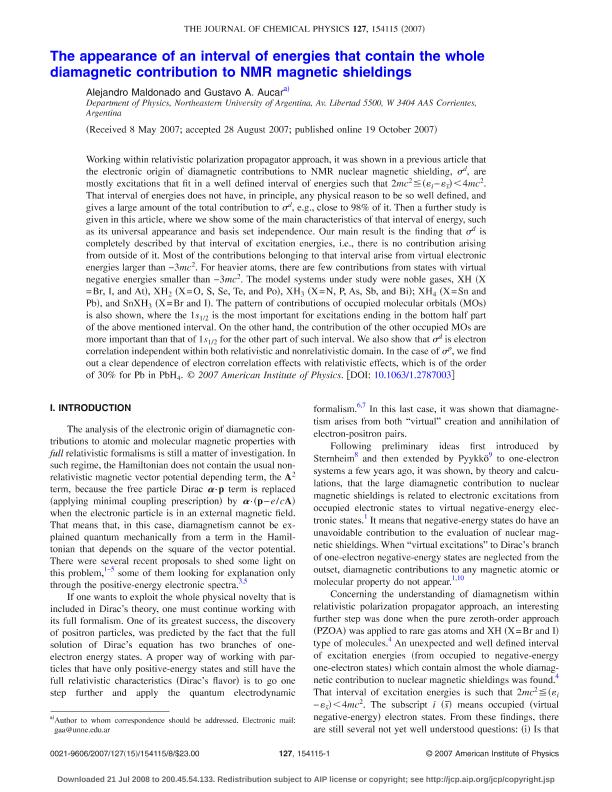Mostrar el registro sencillo del ítem
dc.contributor.author
Maldonado, Alejandro Fabián

dc.contributor.author
Aucar, Gustavo Adolfo

dc.date.available
2017-09-20T15:29:31Z
dc.date.issued
2007-12
dc.identifier.citation
Maldonado, Alejandro Fabián; Aucar, Gustavo Adolfo; The appearance of an interval of energies that contain the whole diamagnetic contributions to NMR magnetic shieldings; American Institute of Physics; Journal of Chemical Physics; 127; 15; 12-2007; 154115-154123
dc.identifier.issn
0021-9606
dc.identifier.uri
http://hdl.handle.net/11336/24675
dc.description.abstract
Working within relativistic polarization propagator approach, it was shown in a previous article that the electronic origin of diamagnetic contributions to NMR nuclear magnetic shielding, σdσd, are mostly excitations that fit in a well defined interval of energies such that 2mc2≦(εi−εs¯)<4mc22mc2≦(εi−εs¯)<4mc2. That interval of energies does not have, in principle, any physical reason to be so well defined, and gives a large amount of the total contribution to σdσd, e.g., close to 98% of it. Then a further study is given in this article, where we show some of the main characteristics of that interval of energy, such as its universal appearance and basis set independence. Our main result is the finding that σdσd is completely described by that interval of excitation energies, i.e., there is no contribution arising from outside of it. Most of the contributions belonging to that interval arise from virtual electronic energies larger than −3mc2−3mc2. For heavier atoms, there are few contributions from states with virtual negative energies smaller than −3mc2−3mc2. The model systems under study were noble gases, XH (X=BrX=Br, I, and At), XH2XH2 (X=OX=O, S, Se, Te, and Po), XH3XH3 (X=NX=N, P, As, Sb, and Bi); XH4XH4 (X=SnX=Sn and Pb), and SnXH3SnXH3 (X=BrX=Br and I). The pattern of contributions of occupied molecular orbitals (MOs) is also shown, where the 1s1∕21s1∕2 is the most important for excitations ending in the bottom half part of the above mentioned interval. On the other hand, the contribution of the other occupied MOs are more important than that of 1s1∕21s1∕2 for the other part of such interval. We also show that σdσd is electron correlation independent within both relativistic and nonrelativistic domain. In the case of σpσp, we find out a clear dependence of electron correlation effects with relativistic effects, which is of the order of 30% for Pb in PbH4PbH4.
dc.format
application/pdf
dc.language.iso
eng
dc.publisher
American Institute of Physics

dc.rights
info:eu-repo/semantics/openAccess
dc.rights.uri
https://creativecommons.org/licenses/by-nc-sa/2.5/ar/
dc.subject
Interval of Energies
dc.subject
Diamagnetic Shielding
dc.subject
Theory of Relativity
dc.subject
Magnetic Shielding
dc.subject
Lead
dc.subject
Electron Correlation Calculations
dc.subject
Diamagnetism
dc.subject.classification
Otras Ciencias Físicas

dc.subject.classification
Ciencias Físicas

dc.subject.classification
CIENCIAS NATURALES Y EXACTAS

dc.title
The appearance of an interval of energies that contain the whole diamagnetic contributions to NMR magnetic shieldings
dc.type
info:eu-repo/semantics/article
dc.type
info:ar-repo/semantics/artículo
dc.type
info:eu-repo/semantics/publishedVersion
dc.date.updated
2017-08-04T15:41:05Z
dc.identifier.eissn
1089-7690
dc.journal.volume
127
dc.journal.number
15
dc.journal.pagination
154115-154123
dc.journal.pais
Estados Unidos

dc.journal.ciudad
Maryland
dc.description.fil
Fil: Maldonado, Alejandro Fabián. Consejo Nacional de Investigaciones Científicas y Técnicas; Argentina. Universidad Nacional del Nordeste; Argentina
dc.description.fil
Fil: Aucar, Gustavo Adolfo. Consejo Nacional de Investigaciones Científicas y Técnicas; Argentina. Universidad Nacional del Nordeste; Argentina
dc.journal.title
Journal of Chemical Physics

dc.relation.alternativeid
info:eu-repo/semantics/altIdentifier/url/http://aip.scitation.org/doi/10.1063/1.2787003
dc.relation.alternativeid
info:eu-repo/semantics/altIdentifier/doi/http://dx.doi.org/10.1063/1.2787003
Archivos asociados
